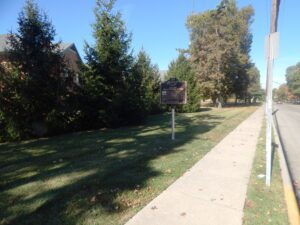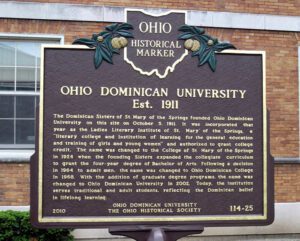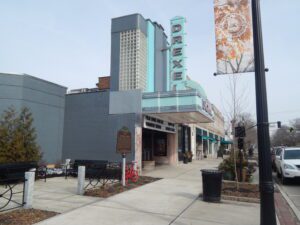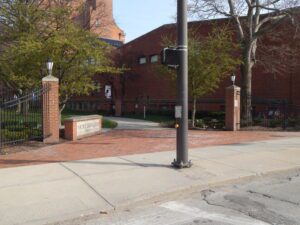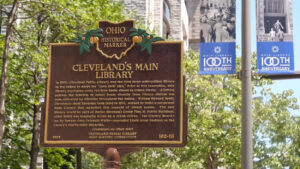, OH
The Sisters of Notre Dame de Namur were founded in 1804 by Saint Julie Billiart to spread the message “Ah, how good it is to serve God.” In 1840, at the request of Bishop John B. Purcell in 1840, the Sisters travelled to Cincinnati, Ohio to help educate the city’s growing Catholic population. Choosing to serve the poor, the Sisters turned down land in Brown County and instead founded schools at Sixth Street in Cincinnati. Since the start of the 21st century, the Sisters serve in twenty-seven other states, the District of Columbia, and in South America, Europe, Africa and Asia. Sister Dorothy Stang, while working for land reforms for the poor in Brazil, was martyred in 2004.
, OH
Sarah Mayrant Walker was born enslaved in Charleston, South Carolina, and sent to New Orleans as a young girl to study under a French hair specialist in the art of hair and scalp treatment, and goods manufacturing. Brought to Cincinnati around 1840, she used her networks to build a hair salon empire that catered to elite and wealthy women. In 1859, Sarah single-handedly desegregated the Cincinnati streetcars when she successfully sued The Passenger Railroad Company after a conductor refused her passage and pushed her off the moving car. As a result, Black women and children could ride inside a streetcar while men could ride on the platform. She and her husband, Peter Fossett, founded First Baptist Church of Cumminsville circa 1870. Both are buried in the Union Baptist Cemetery.
, OH
The Dominican Sisters of St. Mary of the Springs founded Ohio Dominican University on this site on October 5, 1911. It was incorporated that year as the Ladies Literary Institute of St. Mary of the Springs, a “literary college and institution of learning for the general education and training of girls and young women” and authorized to grant college credit. The name was changed to the College of St. Mary of the Springs in 1924 when the founding Sisters expanded the collegiate curriculum to grant the four-year degree of Bachelor of Arts. Following a decision in 1964 to admit men, the name was changed to Ohio Dominican College in 1968. With the addition of graduate degree programs, the name was changed to Ohio Dominican University in 2002. Today, the institution serves traditional and adult students, reflecting the Dominican belief in lifelong learning.
, OH
The Drexel Theatre is a significant example of the once-ubiquitous small neighborhood theatres that appeared in the 1930s, a time when movies were an inexpensive and popular form of entertainment. Designed by architect Robert R. Royce, the theatre was built in 1937 in a combination of Art Deco and Art Moderne styles. The P.F. Yoerger Sign Company designed the iconic marquee. The Drexel opened on Christmas Day 1937, showing the movie One Mile from Heaven, and has been in continuous operation ever since. In 2009, with the theatre falling on hard times, Friends of the Drexel and the Columbus Association for the Performing Arts came together to save and restore this artistic jewel for future generations to cherish. The Drexel Theatre was added to the National Register of Historic Places in 2015.
, OH
In 1886, Bishop Richard Gilmour (1824-1891) of the Roman Catholic diocese of Cleveland requested that the Jesuit superior of Buffalo establish a high school on Cleveland’s west side. The Jesuits, an order of the Roman Catholic Church founded by St. Ignatius Loyola in 1540, sought to establish schools that instilled a zeal for the Gospel and a love of learning. Under the leadership of Father Henry Behren, S.J. (1815-1895), the twentieth Jesuit secondary school in the United States opened in September 1886. Named Saint Ignatius College, the school grew from 76 students in 1886 to 490 in 1924. In 1924, the College split into two separate institutions: John Carroll University, which moved to University Heights in 1935, and Saint Ignatius High School, which remains on its original site. (Continued on other side)
, OH
In 1890, Cleveland Public Library was the first large metropolitan library in the nation to adopt the “open shelf plan.” Prior to this innovation, only library employees could retrieve books stored in closed stacks. Allowing patrons the freedom to select books directly from library shelves was soon embraced by libraries throughout the nation. William Howard Brett, Cleveland’s chief librarian from 1884 to 1918, worked to build a permanent Main Library that embodied this concept of direct access. The new library would be part of Daniel Burnham’s Group Plan of Public Buildings. After Brett was tragically killed by a drunk driver, the Library Board — led by lawyer John Griswold White — appointed Linda Anne Eastman as the library’s fourth chief librarian. (Continued on other side)


